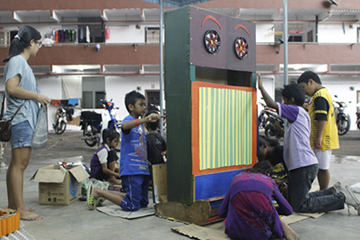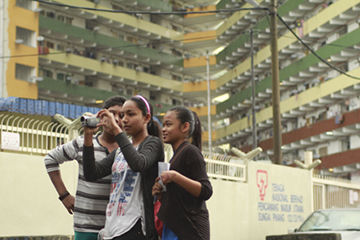Socially Engaged Arts in Asia Today
Janet Pillai (Malaysia)
Founder, Arts-ED / ALFP 2006 Fellow
Social-engaged arts practice is a new kind of public art where artists work on sustained creative practice with communities or groups of people within a social context with intention to bring about humanistic transformation or social change. It may be initiated by practitioners from a wide variety of arts: visual art, theater, media art, architecture, craft, and culinary art. Socially engaged arts practice in Asia today has multiple and hybrid manifestations ranging from collaborative performances and exhibitions with the community to public space activation, co-creation of community festivals and events, or rejuvenation of community cultural assets and practices.
Traditionally, culture and the arts arise out of collective community practice and are entwined in the physical, social and livelihood dimensions of society. However, several factors in Asia today have rendered collective cultural practice and community relations untenable. Highly urbanized environments, the modern work economy, forced migration, rural depopulation, and capitalistic controls disarticulate social and cultural assemblage, contributing to a chasm among art, culture, and society. The devaluation and demise of local cultural practices, social structures and local economies debilitate the role of community as actor, transforming them into apathetic spectators or consumers.
Socially engaged arts practice parallels the rise of small movements in post-industrial Asia, calling for de-growth, work-life balance, endogenous development, cultural rights, inclusion, and green environment. More importantly, socially engaged arts emphasize the recovery of community as actor through “culture and art-making processes.” It shifts the notion of art in a dialogical and reciprocal direction involving intrinsic values such as community sharing, empathy and conviviality. The practice also adopts the principles of accessibility and inclusivity, often collaborating with community and a range of stakeholders. Although criticized by some as compromising art, it is viewed by others as a form of intervention into cultural politics that aims to rejuvenate cultural agency in society.
Governments in Asia are beginning to realize that democratic disengagement and urban alienation cannot be resolved merely through technocracy and that they may lack the vocabulary and expertise to deal with these issues at the community level. Some Asian countries such as Singapore, Taiwan, Thailand and Japan are already considering policy changes that allow for collaboration with cultural agents or cultural collectives to smooth over social, livelihood or environmental problems or to help humanize urban spaces.

(Photo source: Arts-ED)
Government machinery may not be ready to respond in appropriate ways to citizen alienation, but there is increasing evidence of government, institutions and organizations recognizing the contribution of creative individuals, arts and culture as a catalyst to facilitate community building, place making or even participatory planning and policy-making. Socially engaged artists are creative individuals who see themselves as cultural agents. Their activities take the form of interventions into communities or spaces using arts or culture to engage, problem-solve or to initiate change. Where old bureaucratic methods fail, artists are able to apply imagination, creativity and criticality to rejuvenate and to introduce new perspectives or new use, through collective participation and strategic partnerships.
Government-led art projects have a tendency to focus more on the instrumental value of arts and culture: for example, using public art and festivals in order to attract more stakeholders and audiences that can lead to space activation and generate economic benefits. Independent art projects by artists tend to be smaller-scale undertakings, focused on the intrinsic value of the arts: for example, participatory or co-creation activities that encourage social communication and community-building.
In Malaysia, during the years 2008–2018 a government-led company entity called Think City experimented with art projects to kick-start the regeneration of dilapidated urban spaces within four selected towns. Its philosophy is premised on the concept of the creative city and it employs public-private partnerships and crowdsourcing as approaches to democratize the process of ideation and to widen participation. Its main grants program encourages government, business, NGO and community partners to work in collaboration with creative professionals such as writers, artisans, artists, architects or designers in initiatives such as space greening and activation, conservation of cultural assets, capacity building and knowledge dissemination.
Think City’s impact assessment report1 highlighted some interesting findings: its public community-centered grants program helped to build relationships and partnerships, but individual programs were only impactful when linked to a strategic overall framework. Public-private partnerships established on shared values were crucial to success, and initiatives and spaces that were unable to sustain community involvement were more likely to be subsumed by the business sector.

(Photo source: Arts-ED)
In Malaysia, smaller initiatives led by community-engaged arts groups and individuals can be found scattered along the more urbanized west coast, among them being Rakan Mantin, Arts-ED and Buku Jalanan. These small groups tackle a wide range of place-based social issues such as literacy, cultural sustainability and community building using literature, visual arts, street festivals and performing arts.
In Japan, art projects have become the focus of municipalities, student research projects in universities, alternative art spaces and museums. Art projects that involve civic participation are of large and small scale. Large-scale art festivals include the Echigo-Tsumari Arts Triennale and Setouchi Triennale. Both were initiated by municipal and prefectural governments to rejuvenate depopulated local areas and stimulate rural economies. While both festivals attracted a large population of young volunteers and thousands of visitors, this approach led to the threat of their turning into art-tourism events.
The majority of art projects in Japan however remain small scale (Beppu Project, Toride Art Project, Cocoroom) and tend to focus on building social capital, engendering new channels of communication and trust, connecting communities with their locality, and building inclusive communities. In these projects co-creation through art is used to transcend economic, political and social divisions that involve migrants, elderly, homeless or the disabled, creating new solidarities.
In 1990–2012 the Arts Council of Japan supported a project called the Tokyo Art Research Lab in collaboration with Tokyo University of the Arts which ran courses for young people, supported collaborative art projects in the community and published its findings. In its report2 Sumiko Kumakura, the research leader, succinctly describes the characteristics of this new practice in Japan as emphasis on process; site specific with reference to the social context; sustained operations with expectation of ripple effects; and dialogical engagement with diverse peoples and collaboration with social fields outside the arts.
Discussions on art and society in Singapore inevitably touch on the phenomenon that 80% of Singapore residents live in the one million public housing flats owned by the government. Justin Lee and Jui Liang Sim in the article “Arts-based Community Engagement”3 state that socially engaged arts in Singapore work within a landscape of state-sponsored grassroots organizations and controlled community development.
The financial support accorded by the state for socially engaged arts in Singapore is phenomenal compared to neighboring countries, and is a boon to grassroots artists, but it comes with a price. Artists are more likely to receive funding when working in collaboration with social service providers, hospitals and community organizations or with state-supported policies such as building community cohesion, national identity and interracial harmony.
Despite this, socially engaged arts which politicize citizens do grow slowly and subtly in Singapore through the work of organizations such as Dramabox, Participate in Design, Arts Fission Company and Very Special Arts. The intermediary organization ArtsWok Collaborative in Singapore plays a much needed role, negotiating the boundaries and policies for socially engaged artists and providing capacity building and dialogical platforms for the development of this new public arts practice.
In many parts of Asia today socially engaged arts practice (or “applied arts,” if the term can be used rather broadly) is beginning to make an entry into different fields of practice: disaster mitigation, urban revitalization, health and education, migration, heritage and environmental conservation, conflict management and elderly care. The role and impact of socially engaged arts practice in Asia certainly merits more documentation and investigation. Of course this also entails developing new ways of measuring its impact on the social, emotional and physical well-being of communities.
While postindustrial countries in Asia are concerned over the loss of collective agency among its citizens, governments remain cautious about returning agency to citizens (i.e., inspiring them to imagine, define and create a future for themselves) as it requires a new politics and a new approach to the public sphere. The process may require an inversion of the industrial model: decentralization, providing individuals accessibility to tools and more manageable scales of production, allowing public control, adopting principles of small market or sharing economies and horizontal social structures.
The contents of this article reflect solely the opinions of the author.



